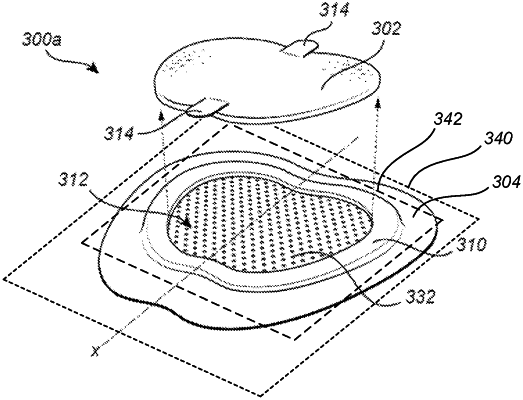| CPC A61F 13/00085 (2013.01) [A61F 13/0206 (2013.01); A61F 17/00 (2013.01); A61F 2013/00272 (2013.01); A61F 2013/00404 (2013.01); A61F 2013/00817 (2013.01)] | 14 Claims |

|
1. A medical dressing for application at a treatment area of a human body for reducing the risk of pressure sores, comprising:
(a) an annular border area surrounding (b) a central inspection area,
the annular border area and the central inspection area formed of a perforated film, the perforated film having a body-facing proximal side and an opposite distal side, wherein perforations of the perforated film extend between the body-facing proximal side and the opposite distal side,
the perforated film of the annular border area comprising:
—the body-facing proximal side provided with an adhesive layer for adhering the annular border area to skin surrounding said treatment area; and
—a backing layer applied to the opposite distal side of the perforated film, covering the perforations,
wherein the central inspection area is for alignment with said treatment area,
wherein the central inspection area is defined by a raised wall portion which is surrounded by said annular border area,
wherein said perforated film lies in a first geometrical plane and the raised wall portion projects distally from said first geometrical plane,
wherein the raised wall portion at least partly defines a frame around said central inspection area,
wherein a thickness of the annular border area is smaller than a thickness of the raised wall portion,
wherein a distal end surface of said raised wall portion and a distal end surface of a pad lie in a common second geometrical plane, said second geometrical plane being parallel with said first geometrical plane,
wherein the central inspection area comprises an opening that is a blind hole, a bottom of the blind hole being formed by said perforated film that extends into and across the central inspection area,
wherein the perforations across the central inspection area allow moisture to be transported away from the skin,
(c) said pad positionable within the central inspection area, the pad movable between at least two states:
—a first state in which the pad is located in the central inspection area, positioned over the perforated film and is positioned within the central inspection area such that a proximate end surface of said pad contacts the perforated film of the central inspection area for providing a pressure relieving function; and
—a second state in which the pad is at least partly removed from the central inspection area for enabling visual inspection of said treatment area, and wherein the pad further comprises:
—a first absorbent layer comprising a foam material;
—a second absorbent layer comprising a superabsorbent material; and
wherein an adhesive strength between the pad and the perforated film is between 1 N/25 mm and 3 N/25 mm.
|